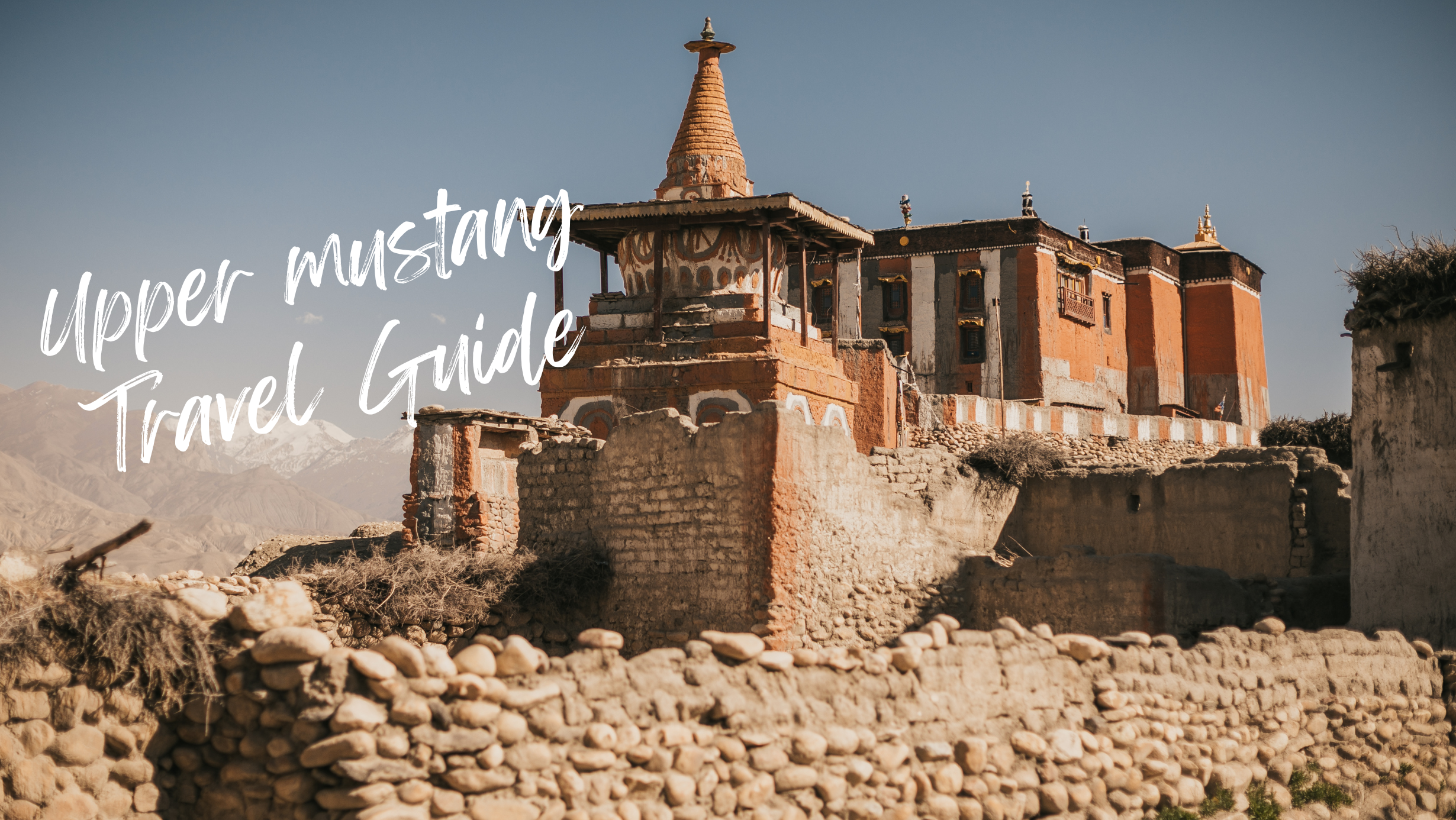Upper Mustang Travel Guide
Upper Mustang Travel Guide Explore the Forbidden Kingdom of Nepal
Introduction
Upper Mustang Travel, often referred to as the “Last Forbidden Kingdom”, is one of the most culturally rich and geographically stunning regions in Nepal. Nestled in the rain shadow of the Himalayas, this remote and mystical land offers an unparalleled journey through ancient Tibetan Buddhist culture, dramatic landscapes, and historical treasures. This comprehensive travel guide will provide you with all the essential information you need to plan your Upper Mustang adventure, ensuring a trip filled with wonder and discovery.
Why Visit Upper Mustang?
Unique Cultural Heritage
Upper Mustang is a living museum of Tibetan Buddhist culture. The region was closed to foreigners until 1992, which has helped preserve its unique heritage and traditions. Monasteries, ancient caves, and the medieval walled city of Lo Manthang are testaments to its rich history.
Breathtaking Landscapes
The landscapes of Upper Mustang are unlike any other in Nepal. From the barren, wind-swept valleys to the colorful rock formations and high-altitude deserts, the scenery is both stark and stunning. The region’s isolation has protected its natural beauty, offering an unspoiled and serene environment for trekkers.
Adventure and Exploration
For those seeking adventure, Upper Mustang provides a challenging and rewarding trekking experience. The region’s trails traverse rugged terrain, cross high mountain passes, and offer panoramic views of the Annapurna and Dhaulagiri ranges. Each step of the journey reveals new and awe-inspiring vistas.
Planning Your Upper Mustang Trip
Best Time to Visit
The best time to visit Upper Mustang is during the spring (March to May) and autumn (September to November) seasons. During these months, the weather is stable, and the skies are clear, offering the best conditions for trekking and sightseeing. The Tiji Festival, celebrated in May, is a vibrant cultural event that attracts many visitors.
Permits and Regulations
Upper Mustang is a restricted area, and special permits are required for entry. Travelers need to obtain the Upper Mustang Restricted Area Permit, which costs around USD 500 per person for a 10-day stay. Additionally, a Trekkers’ Information Management System (TIMS) card is also required. These permits can be arranged through registered trekking agencies in Kathmandu or Pokhara.
Getting There
The journey to Upper Mustang typically begins with a flight from Kathmandu to Pokhara, followed by another short flight or a jeep ride to Jomsom. From Jomsom, the trek to Lo Manthang and other parts of Upper Mustang begins. The trek can be customized based on your preferences and fitness level, with options for both guided and independent trekking.
Exploring Upper Mustang
Major Attractions
Lo Manthang
Lo Manthang, the ancient walled city and the capital of Upper Mustang, is the crown jewel of the region. Its narrow streets, whitewashed houses, and magnificent monasteries exude a timeless charm. Key attractions in Lo Manthang include the Jampa Lhakhang (God House), Thubchen Gompa, and the Royal Palace.
Monasteries and Caves
Upper Mustang is home to numerous monasteries and ancient caves that hold significant historical and religious importance. The Chhoser Cave, located near Lo Manthang, is a complex of more than 40 rooms carved into a cliff, believed to date back over 2,500 years. The Ghar Gompa, a revered Buddhist monastery, is another must-visit site, known for its spiritual significance and beautiful murals.
Trekking Routes
Classic Upper Mustang Trek
The classic Upper Mustang trek is a journey of approximately 12-14 days, starting from Jomsom and making its way through Kagbeni, Chele, Syanbochen, Ghami, Tsarang, and finally reaching Lo Manthang. The return journey follows a similar route, with opportunities to explore additional villages and monasteries.
Upper Mustang and Damodar Kunda Trek
For those seeking a more challenging and off-the-beaten-path experience, the Upper Mustang and Damodar Kunda trek is an excellent choice. This trek extends beyond Lo Manthang to the sacred lakes of Damodar Kunda, situated at an altitude of 4,890 meters. The trek offers stunning views and a deeper immersion into the remote areas of Mustang.
Preparing for Your Trek
Physical Fitness and Training
Trekking in Upper Mustang requires a good level of physical fitness due to the high altitudes and rugged terrain. It’s advisable to undertake a fitness regimen that includes cardiovascular exercises, strength training, and hiking practice. Acclimatization is also crucial to prevent altitude sickness.
Essential Gear and Packing List
Packing the right gear is essential for a comfortable and successful trek. Key items to include are:
Trekking boots: Sturdy, waterproof, and broken-in.
Clothing layers: Moisture-wicking base layers, insulating mid-layers, and waterproof outer layers.
Trekking poles: Helpful for stability on uneven terrain.
Sleeping bag: Rated for sub-zero temperatures.
First aid kit: Including altitude sickness medication.
Sunscreen and sunglasses: The high-altitude sun can be intense.
Water purification: Tablets or a filter for safe drinking water.
Accommodation and Food
Accommodation in Upper Mustang ranges from basic teahouses to more comfortable lodges in Lo Manthang. Teahouses offer simple rooms with shared facilities, while lodges may provide private rooms with attached bathrooms. Meals typically include Nepali staples such as dal bhat (lentil soup with rice), noodles, and Tibetan bread. It’s important to bring some snacks and hydration solutions, especially for the longer trekking days.
Cultural Etiquette and Tips
Respect Local Customs
Upper Mustang is a region deeply rooted in Tibetan Buddhist traditions. Visitors should respect local customs and practices, such as:
Dressing modestly, especially when visiting monasteries and religious sites.
Asking for permission before taking photographs of people or religious ceremonies.
Refraining from touching or pointing at religious objects with your feet.
Learning Basic Nepali or Tibetan Phrases
Learning a few basic phrases in Nepali or Tibetan can greatly enhance your experience and help you connect with the local people. Simple greetings and expressions of gratitude are always appreciated.
Environmental Responsibility
Leave No Trace
Trekking in Upper Mustang means traveling through pristine and fragile environments. Adhering to Leave No Trace principles is crucial to preserve the natural beauty and cultural heritage of the region. This includes packing out all trash, minimizing campfire impacts, and respecting wildlife.
Supporting Local Communities
Choosing locally-owned teahouses, guides, and porters helps support the local economy and ensures that tourism benefits the communities in Upper Mustang. Engaging with local guides also provides valuable insights into the culture and history of the region.
Conclusion
A journey to Upper Mustang is a step back in time, offering a rare glimpse into a world that has remained largely untouched by modernity. From its dramatic landscapes and ancient monasteries to the rich tapestry of Tibetan Buddhist culture, Upper Mustang promises an adventure like no other. By planning carefully, respecting local customs, and embracing the spirit of exploration, you can experience the magic of the Last Forbidden Kingdom and create memories that will last a lifetime. Embark on this extraordinary journey and discover the hidden treasures of Upper Mustang, Nepal.





